To capture sky-high tennis action like a pro, you'll need the right drone and camera settings. Choose a small, agile drone with a 4K camera and 3-axis gimbal for stability. Set your shutter speed to at least 1/1000s to freeze fast-paced action, and use continuous autofocus to track players. Position yourself at an elevated angle for thorough court coverage, and anticipate player movements to frame dynamic shots. Employ burst mode to capture critical moments during rallies and serves. Don't forget to highlight crowd reactions and incorporate wide shots of the stadium. With these tips, you'll be well on your way to capturing stunning aerial tennis footage. Discover more advanced techniques to elevate your game even further.
Choosing the Right Drone
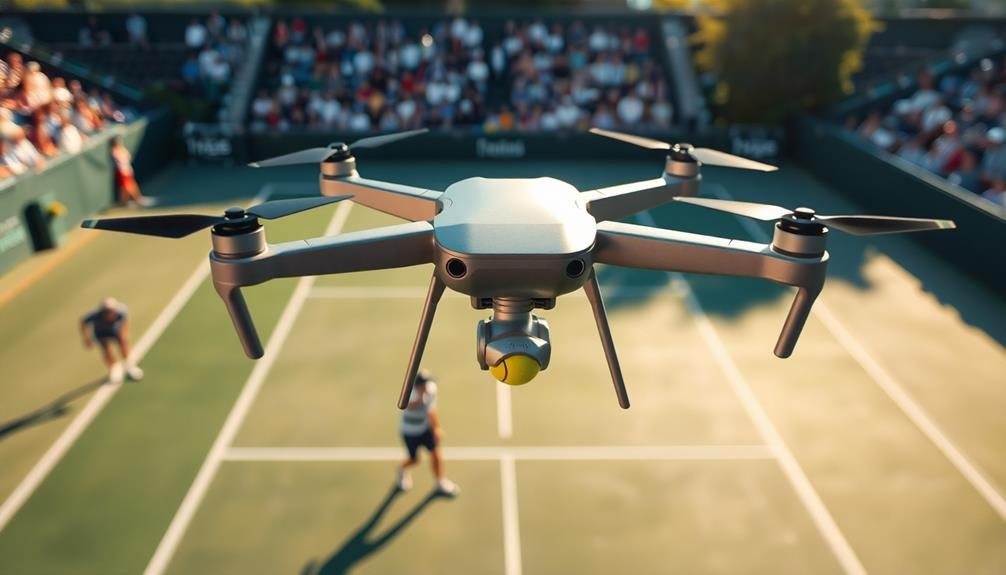
Drone selection can make or break your tennis footage. When choosing a drone for tennis videography, prioritize models with high-quality cameras, stable flight performance, and long battery life.
Look for drones equipped with at least a 4K camera and a 3-axis gimbal for smooth, professional-looking shots. Consider the drone's size and weight, as smaller, more agile models are often better suited for capturing fast-paced tennis action.
Verify your chosen drone has intelligent flight modes, such as tracking and orbit, which can help you capture dynamic shots of players and court action.
Pay attention to the drone's maximum flight time and range. You'll want a model that can stay airborne for at least 20-30 minutes to capture extended rallies or entire matches.
Additionally, check local regulations regarding drone usage at tennis venues, as some locations may have restrictions. Invest in a drone with obstacle avoidance technology to prevent collisions with court structures or other objects.
Camera Settings for Tennis Action

In light of the fast-paced nature of tennis, proper camera settings are essential for capturing crisp, clear action shots. You'll want to prioritize fast shutter speeds to freeze the action. Aim for at least 1/1000th of a second, or even faster if lighting permits. This will help you capture sharp images of players mid-swing or as the ball zooms across the court.
Adjust your aperture to balance depth of field with light intake. A wider aperture (lower f-number) lets in more light but narrows your focus area. For singles matches, you might opt for f/4 to f/5.6, while doubles may require f/8 to keep more players in focus.
Set your ISO as low as possible while maintaining adequate exposure. Start at ISO 100 or 200 and increase as needed. Modern cameras can handle higher ISOs without significant noise, so don't be afraid to push it if necessary.
Use continuous autofocus (AF-C) mode to track moving subjects. Select a focus point or area that corresponds to where you expect the action to occur. Burst mode is vital for capturing the perfect moment in a rally or serve.
Positioning for Optimal Coverage

When filming tennis, you'll need to choose between court-side and elevated angles for your shots.
Court-side positions offer intimate, low-angle views of the players, while elevated angles provide a broader perspective of the entire court.
To capture the most dynamic footage, you should adopt a "follow the ball" strategy, anticipating the play and smoothly tracking the action as it unfolds.
Court-side vs. Elevated Angles
Positioning yourself for the best tennis shots comes down to a choice between court-side and elevated angles. Court-side angles offer an immersive perspective, putting viewers right in the action. You'll capture players' intensity, swift footwork, and powerful serves up close. This angle is ideal for dramatic shots and player reactions, but it can be challenging to follow the ball's trajectory.
Elevated angles, on the other hand, provide a broader view of the court. You'll be able to capture the entire playing field, making it easier to follow rallies and showcase players' positioning strategies. This perspective is excellent for highlighting tactical play and giving viewers a thorough understanding of the match.
To maximize your coverage, consider switching between these angles. Use court-side shots for serve close-ups, player emotions, and vital points. Shift to elevated angles for extended rallies, tactical analysis, and overall game flow.
Follow the Ball Strategy
The golden rule of tennis cinematography is to follow the ball. As a cameraman, your primary focus should be tracking the ball's movement across the court. This strategy guarantees you capture the most vital moments of the match and maintain viewers' engagement.
To effectively follow the ball, position yourself strategically. If you're using a single camera, opt for a central location behind the baseline. This vantage point allows you to pan smoothly from side to side, keeping the ball in frame throughout rallies.
For multi-camera setups, place additional cameras along the sidelines to capture cross-court shots and player reactions.
Anticipate the game's flow by studying players' patterns and tendencies. This knowledge will help you predict where the ball is likely to go, allowing for smoother camera movements.
Use a mix of wide and tight shots to provide context and highlight intense moments. During serves, focus on the server before quickly shifting to a wider view as the rally begins.
Remember to adjust your zoom levels based on the ball's proximity to the camera. Zoom out for long rallies and zoom in for net play or dramatic points.
Tracking Fast-Moving Players
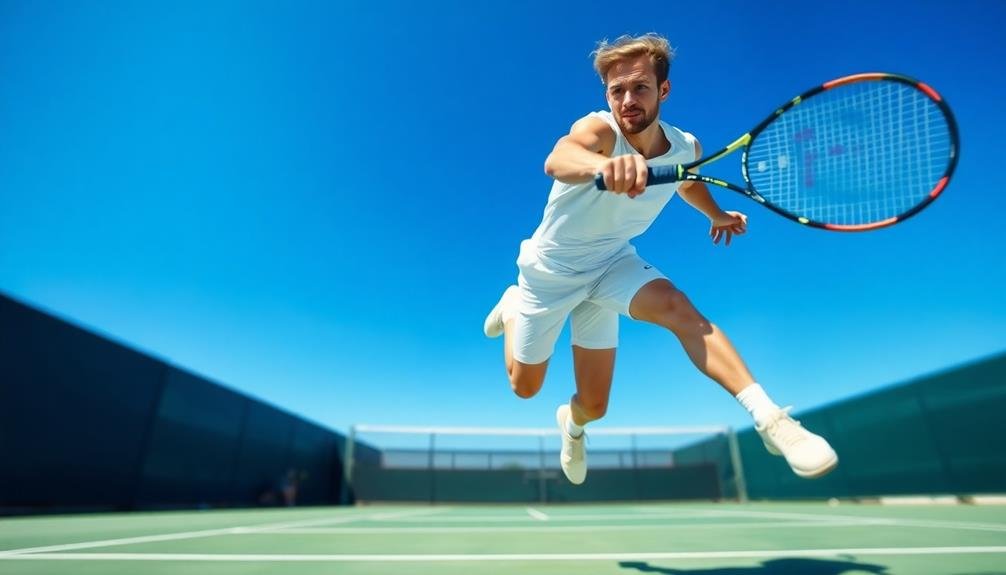
Capturing fast-moving tennis players can be one of the most challenging aspects of sports photography. You'll need to master the art of anticipation and quick reflexes to get those perfect shots. Start by familiarizing yourself with the players' movements and patterns. This knowledge will help you predict where they'll be next, allowing you to frame your shots in advance.
Use continuous autofocus mode to keep your subject sharp as they move across the court. Set your camera to a high shutter speed, typically 1/1000s or faster, to freeze the action. Don't be afraid to crank up your ISO if needed to maintain these fast shutter speeds.
Consider using burst mode to capture a series of shots in quick succession. This technique increases your chances of getting that perfect moment when the player's form is at its peak.
| Technique | Purpose | Recommended Settings | Tips |
|---|---|---|---|
| Continuous AF | Track moving subjects | AF-C mode | Pre-focus on expected position |
| High Shutter Speed | Freeze action | 1/1000s or faster | Adjust ISO as needed |
| Burst Mode | Capture peak moments | High-speed continuous | Review and select best shots |
| Wide Aperture | Isolate subject | f/2.8 – f/4 | Be mindful of depth of field |
Remember to stay mobile and adjust your position as the match progresses. This flexibility will help you capture a diverse range of shots and angles throughout the game.
Capturing Serve and Volley Moments

To capture serve and volley moments in tennis, you'll need to anticipate player movements and be ready to act quickly.
Mastering quick focus techniques will help you keep up with the rapid shifts from serve to net approach.
Set your camera to high-speed shutter settings to freeze the action and capture crisp images of these dynamic plays.
Anticipate Player Movements
Anticipation is key when capturing serve and volley moments in tennis. You'll need to predict where the action will unfold and position yourself accordingly.
Develop an understanding of player tendencies and court positioning to stay one step ahead.
Watch for subtle cues that telegraph a player's next move. These might include their grip on the racket, foot placement, or body angle. As you become more familiar with individual players' styles, you'll better foresee their strategies.
To improve your anticipation skills, focus on these four areas:
- Study player statistics and match history
- Observe warm-up routines to gauge player form
- Pay attention to coaching interactions during changeovers
- Notice patterns in serve placement and return positioning
Don't forget to take into account external factors like wind direction and court surface, which can influence player movements.
By honing your anticipation skills, you'll be ready to capture those split-second serve and volley moments that define a match.
Quick Focus Techniques
When it comes to capturing serve and volley moments, you'll need to master quick focus techniques. These fast-paced exchanges demand lightning-fast reactions and precise focusing. To nail these shots, practice using your camera's continuous autofocus mode, which tracks moving subjects. Pre-focus on the serving player, then quickly shift to the receiving player as the ball crosses the net.
Use a wide aperture (low f-number) to create a shallow depth of field, isolating the player from the background. This technique helps emphasize the athlete's movements and expressions. Experiment with different focus points, such as the player's eyes or racket, to add variety to your shots.
Here's a quick reference guide for focus techniques:
| Technique | Serving Player | Receiving Player |
|---|---|---|
| Focus Point | Tossing hand | Ready position |
| Tracking | Upward motion | Split-step |
| Moment of Impact | Ball contact | Racket preparation |
| Follow-through | Body rotation | Approach to net |
| Recovery | Return to baseline | Volley positioning |
High-Speed Shutter Settings
High-speed shutter settings are the backbone of capturing crisp, action-packed serve and volley moments in tennis. To freeze the action and capture every detail, you'll need to set your camera's shutter speed to at least 1/1000th of a second. This fast shutter speed will help eliminate motion blur and guarantee that the ball, racket, and player are all tack-sharp in your images.
When shooting serve and volley sequences, consider these key points:
- Use continuous shooting mode to capture multiple frames in quick succession.
- Set your camera's autofocus to AI Servo or Continuous AF for tracking moving subjects.
- Increase your ISO if necessary to maintain a fast shutter speed in low light conditions.
- Choose a wider aperture (lower f-number) to allow more light and create a shallow depth of field.
Framing Court-Wide Shots
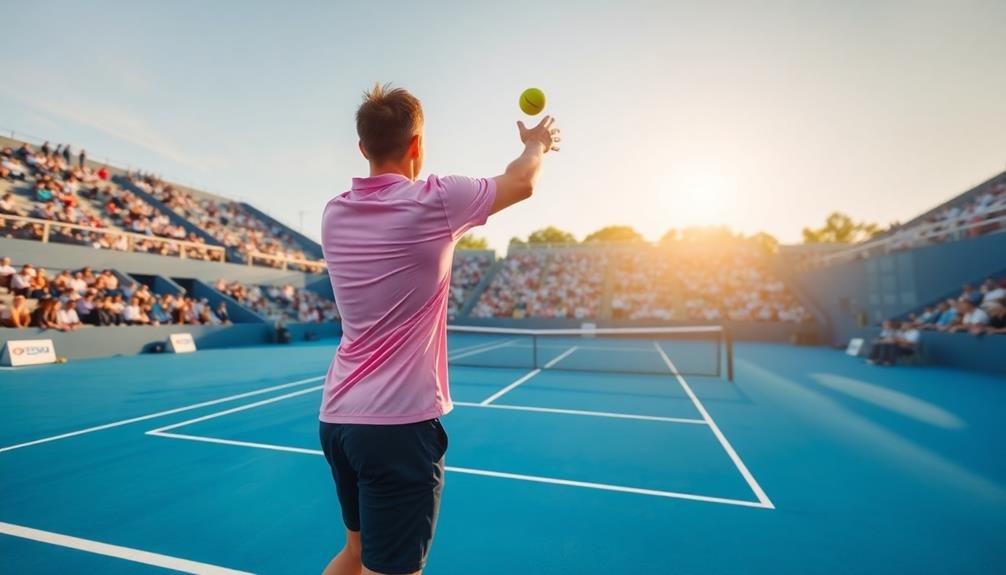
Mastering court-wide shots is essential for capturing the full scope of a tennis match. You'll want to position yourself at an elevated vantage point, typically behind the baseline or in the stands. Use a wide-angle lens to encompass the entire court, ensuring you don't crop out any significant action.
When framing your shot, consider the rule of thirds. Place the net along one of the vertical lines and position players near the intersecting points. This composition creates a visually appealing balance while highlighting the game's key elements.
Here's a quick reference guide for framing court-wide shots:
| Element | Placement |
|---|---|
| Net | Vertical third line |
| Players | Intersection points |
| Court lines | Horizontal third lines |
| Scoreboard | Upper right corner |
| Crowd | Background, top third |
Remember to leave some headroom above the players for potential high shots or jumps. Adjust your framing as the match progresses, anticipating where the action might move. By mastering these techniques, you'll capture compelling court-wide shots that tell the complete story of the tennis match.
Highlighting Crowd Reactions
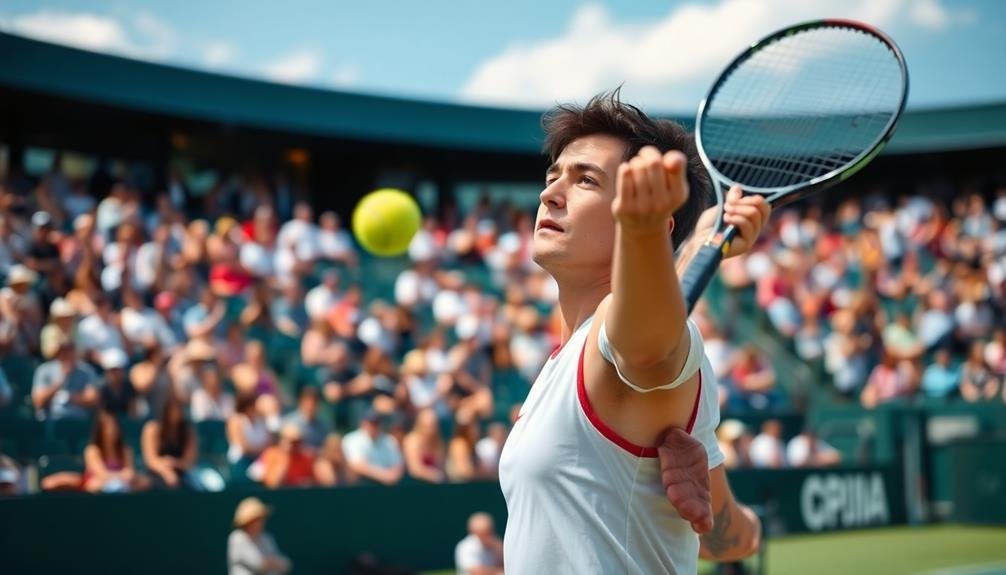
Capturing crowd reactions adds depth and emotion to your tennis coverage. It's vital to balance your focus between the on-court action and the spectators' responses. To effectively highlight crowd reactions, position yourself strategically around the court, allowing for quick pans to the audience during breaks in play or after significant points.
When showcasing crowd reactions, consider these key techniques:
- Use a longer lens to isolate individual faces or small groups, capturing genuine emotions and expressions.
- Anticipate big moments and be ready to switch to the crowd immediately after an important point or match-ending play.
- Scan for celebrity attendees or passionate fans, as their reactions often resonate with viewers.
- Incorporate wide shots of the entire stadium to showcase the overall atmosphere and energy.
Remember to vary your shots between close-ups and wider angles to maintain visual interest.
Pay attention to the rhythm of the match, using crowd reactions to punctuate dramatic moments or fill natural lulls in play.
Post-Production Editing Techniques
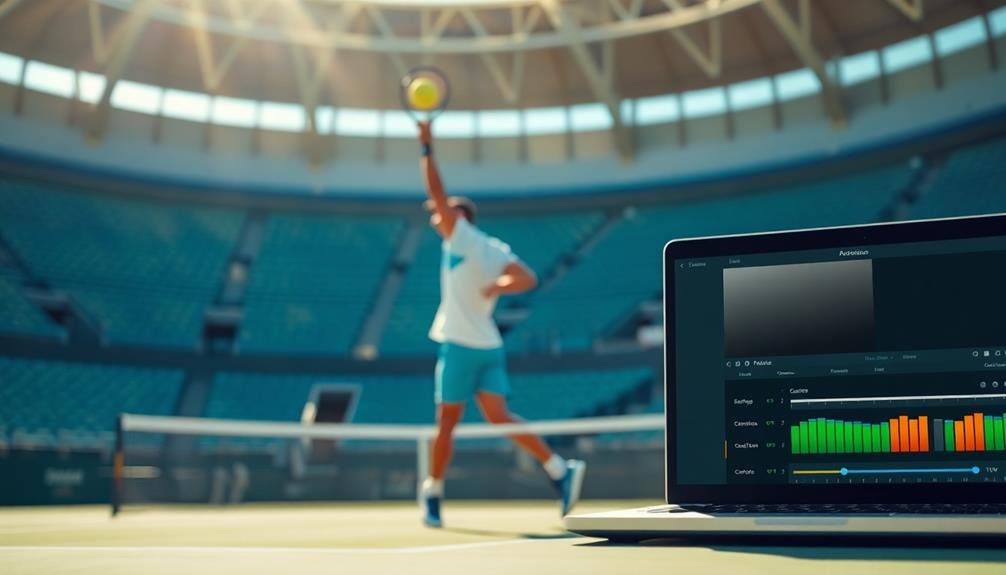
Once you've captured all the footage, post-production editing is where your tennis coverage truly comes to life. Start by organizing your clips, creating separate folders for match footage, player close-ups, and crowd reactions. This will streamline your workflow and save time during editing.
Use color correction to guarantee consistency across all shots, especially if you've filmed with multiple cameras. Adjust white balance, exposure, and contrast to create a cohesive look.
When cutting between shots, use smooth shifts like dissolves or match cuts to maintain visual flow. Incorporate slow-motion replays for key moments, such as powerful serves or dramatic volleys.
Add on-screen graphics for player names, scores, and statistics to enhance viewer understanding. Don't forget to include establishing shots of the venue to set the scene.
Sound editing is vital in tennis coverage. Balance crowd noise with on-court sounds and commentary. Use ambient court sounds during quiet moments to maintain atmosphere.
Legal Considerations for Aerial Filming

The legal landscape for aerial filming in tennis tournaments can be complex and varies by location. Before you launch your drone, it's essential to understand and comply with local regulations to avoid legal issues and guarantee safety.
First, familiarize yourself with national aviation authority rules. In the US, the Federal Aviation Administration (FAA) requires drone operators to obtain a Remote Pilot Certificate for commercial use. You'll also need to register your drone if it weighs more than 0.55 pounds.
Always obtain permission from the tournament organizers and venue owners before flying. They may have specific restrictions or requirements for aerial filming. Be aware of privacy concerns and avoid capturing footage of spectators or private areas without consent.
When operating your drone, follow these key guidelines:
- Maintain visual line of sight with your drone at all times
- Don't fly over people or moving vehicles
- Respect restricted airspace and no-fly zones
- Stay below the maximum altitude limit (usually 400 feet in the US)
Frequently Asked Questions
How Do You Handle Unexpected Weather Changes During a Tennis Match Shoot?
You'll need to adapt quickly. Keep weather-resistant gear handy and adjust your camera settings for changing light. Stay flexible with your shooting position, and be prepared to move or protect your equipment if conditions worsen.
What Insurance Considerations Are Necessary for Drone-Based Tennis Photography?
You'll need extensive drone insurance covering liability, equipment damage, and potential injuries. Don't forget to include coverage for your camera gear. Always check local regulations and obtain necessary permits before flying at tennis events.
How Can You Minimize Disruption to Players When Filming With Drones?
You'll want to fly your drone high and far from the court to minimize noise. Use a powerful zoom lens, schedule flights between matches, and always follow tournament guidelines. Communicate your plans with players and officials beforehand.
Are There Specific Drone Models Recommended for Professional Tennis Tournaments?
You'll want to contemplate DJI's Inspire 2 or Mavic 3 Pro for pro tennis tournaments. They're quiet, stable, and offer high-quality 4K footage. Always check with tournament organizers for specific drone regulations before flying.
How Do You Synchronize Multiple Drones for Comprehensive Court Coverage?
You'll need to use a synchronized control system for multiple drones. Connect them to a central hub, program flight paths, and assign roles. Use GPS for positioning and real-time communication to coordinate movements and avoid collisions.
In Summary
You've now got the tools to capture stunning aerial tennis footage. Remember to practice your drone skills, refine your camera settings, and plan your shots carefully. Don't forget to take into account legal requirements and obtain necessary permissions. With these tips, you'll be able to create dynamic, professional-quality tennis coverage that'll wow your audience. Keep experimenting and pushing your creative boundaries to take your aerial tennis cinematography to new heights.

As educators and advocates for responsible drone use, we’re committed to sharing our knowledge and expertise with aspiring aerial photographers.




Leave a Reply